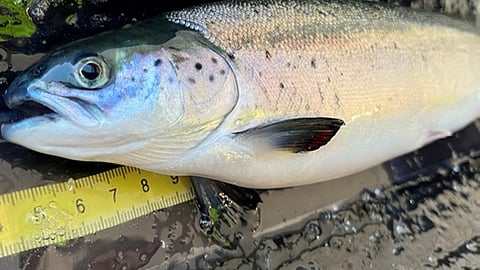

In a controlled experiment, Atlantic salmon raised at various temperatures developed as expected - but once moved to seawater, one group produced results that caught Nofima’s researchers by surprise.
Photo: Anja Striberny / Nofima
Atlantic salmon reared in warmer freshwater conditions grew faster after transfer to seawater than those raised at lower temperatures, according to new research from Norwegian food research institute Nofima.
The trial, conducted at Nofima’s aquaculture research station in Sunndalsøra and later at a seawater site in Gildeskål, aimed to assess how temperature affects salmon health and development throughout the production cycle.
Temperature is known to be a key regulator of fish biology, influencing growth, physiology, and welfare. Concerns have been raised in recent years that higher rearing temperatures could lead to health problems, such as poor heart development, or that fast-growing juvenile fish may struggle after transfer to sea.
“There was a lack of long-term experiments assessing the effects of temperature from smolt to harvest,” said Nofima scientist Anja Striberny. “We needed this to determine whether high temperatures early in life would impact salmon growth and health later on.”
The study involved rearing salmon at three different freshwater temperatures - 8, 12, and 14°C - in both flow-through and recirculating aquaculture systems (RAS). After smoltification, they were transferred to seawater and monitored for growth, survival, and health.
The Nofima researchers report that as they expected, fish from warmer groups were larger at transfer: the 14°C group averaged 140 grams, compared with 70 grams in the 8°C group.
However, what surprised the scientists was that this growth advantage persisted after transfer to sea.
The reasons remain unclear, but the researchers suggest it could be linked either to higher pre-transfer weight or to lasting physiological effects of early temperature exposure.
Anja Striberny (to the right) and research colleagues from Nofima, UiT and staff at Gifa's research station during the trial, where they investigate how salmon responds to early-life high temperature exposure.
Photo: Nofima
All fish groups showed good seawater tolerance and high survival, with few visible welfare differences. However, the researchers emphasised that growth and survival tell only part of the story, and the team is still analysing tissue samples and molecular data to identify possible underlying or “invisible” effects of temperature.
Small but important tendencies among fish reared at higher temperatures were noted in the study, including slightly smaller hearts and mild cataracts late in the seawater phase. Smaller hearts were also observed in fish raised in RAS.
The researchers also found that fish from the 12°C and 14°C groups later produced a higher proportion of superior-quality fillets, with more intense colouration, described as a potential commercial advantage.
The group concluded that water temperatures up to 14°C during the smolt production phase appear “unproblematic” and may even be beneficial for long-term growth, provided that other environmental parameters remain optimal.
However, Striberny warned that the results of the study should not be interpreted in isolation. “We only manipulated temperature in this trial. Density and water quality were kept well within recommended levels, and changes to those parameters could produce different results,” she said.
The study was funded by the Norwegian Seafood Research Fund (FHF) under its “Robust Fish” research area. FHF’s Head of Research, Sven Martin Jørgensen, said the findings should be viewed alongside other ongoing projects.
“When several of the projects have delivered their recommendations, it will be important to compile the results so that the aquaculture industry can gain updated knowledge about which early production conditions produce a farmed salmon with the best possible health and performance,” he said.
The work was carried out under the project Temp-Int by Nofima in collaboration with the Arctic University of Norway (UiT), University of Bergen (UiB), Norwegian University of Science and Technology (NTNU), and salmon farming companies Mowi, Grieg Seafood, and Cermaq.
